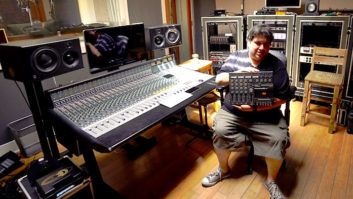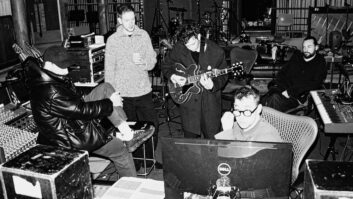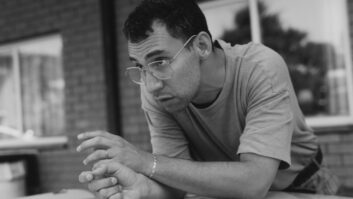Early in 2007, Jack Johnson began remodeling an old L.A. mansion that also houses a recording studio and offices for his record label, Brushfire Records. Eco-friendly building renovations were made, and last June he began tracking his new album, Sleep Through the Static, out this month. The album was produced by J.P. Plunier, with recording and mixing by engineer Robert Carranza, and features Johnson’s band: Merlo Podlewski on bass, Adam Topol on drums and Zach Gill on keyboards. In contrast to the Pro Tools production on Johnson’s recent albums, the group went analog this time, tracking to Studer 24-track. “I liked not looking at the music on a computer screen — just hearing it,” says Johnson. “If it had a good feel, you moved on, living with your little mistakes. Those little mistakes become part of the character of the song.
“I am not a real audiophile; I leave that stuff to Robert,” Johnson continues. “The guys in the band can hear the difference between tape and digital. I have always been more into the songwriting and putting the song together. But it feels really warm, and we aren’t using a click. We just go sit in the room together and track the songs.”
Jack Johnson with his guitar on the steps of his new recording studio, Solar Plastic Power Plant. “We found this old building in Los Angeles with a room in the back with high ceilings — perfect for a studio,” says Johnson. “We wanted to make it as eco-friendly as possible: We put the solar panels on the roof. We are using bamboo for the floors, which is a replaceable resource, and we used the old wood to put in floors and ceilings in the house. We have toilets with the low-flush option, and the insulation in the walls is all recycled blue jeans. When you have the chance to do it this way, why not do it?”
“We used a variety of microphones for the drums,” says Carranza. “For the overheads, we used Audio-Technica 4050s. They have a nice top-end brilliance and warmth. You can get them really close to the cymbals and they sound really good. For the toms, we used standard 451s. Snare was a 57 with a 451 tied to it, bottom snare was a 451. Hi-hat was a 451. On the kick drum, we had an [AKG] D 12, which has a nice ‘pump’ to it. Adam [Topol’s, above] sound is very much how he plays, and he tunes them a certain way that works for him. We put up a stereo room mic about three feet back, an AKG, which gives an overall sound for everything.”
Engineer Robert Carranza positions a Telefunken | USA U 47AE. “He is our sound now,” says Johnson of his longtime engineer. “In a certain way, he is in the band.”
“Jack has kind of a velvet voice, and this is the first time I really got the sound I have been trying to get all along,” says Carranza. On the guitar is an Audio-Technica 4050.
Zach Gill’s keyboards include Celeste, Clavinet, Wurlitzer, Rhodes, Moog and piano. “He did most of the piano live,” explains Carrana. “It was blocked off, with the soundboard faced away from the drums with a little gobo, some 451s and that was our tracking style. Sometimes he played through a little Fender Deluxe amp miked with a [Shure] 57.” Pianos went through two Neve 1073s miked L/C/R using less of the center to create space.
Carranza miked Johnson’s acoustic guitar with an AKG. “Jack is such a mellow player. He would sometimes play acoustic, sometimes electric, all done live in the room,” Carranza says. “One of the best things about making this record is that we used the Avion headphone system. You can discretely send tracks to each player and everyone can make and store their own mixes.”
Analog treats (top-bottom): Summit Audio DCL-200 Dual compressor/limiter, Empirical Labs EL-7 Fatso Jr., Ridge Farm Boiler ultra compressor. (“Serial number 35,” says Carranza. “When you want something to go crazy, put it through that box.”), Tube-Tech-Dual Compressor CL 2A. Lindcraft Denmark tube stereo compressor, TLA-100A Summit tube leveling amplifier, and a Teletronix LA2A original limiter. (“When used with an amplifier, it zooms in on sound and brings out all the little characteristics that are in there.”)
Many amps on the project were borrowed from producer J.P. Plunier’s collection. “The one on the left is a Bell stereo amplifier that has two inputs so you can create a stereo effect; we used that one quite a bit,” says Carranza. “The little orange one is an old Gibson. We also used the little combo on the bottom with the tweed design. Standard miking [included] an SM7 or a 57; sometimes, I put the 251 on the amp farther back.”
Overall, signal chains were simple. “All the drums went through APIs,” says Carranza. “Room mics went through Neves. API straight in, straight to tape, with just a little bit of API EQ. Adam has his drums dialed in, and they sound good the way they are. Jack’s acoustic went through a Neve, bass went through the UA 610s with those great tube electronics.” Vocals went through an API mic pre from the Telefunken | USA U-47 re-issue into the API 512, into an LA-2A and straight into tape. “We used the 1176 every once in a while, not too much; this is more of an LA-2A kind of record. No aggressive stuff.” Acoustic guitars went through APIs with graphic EQ to add high end.







